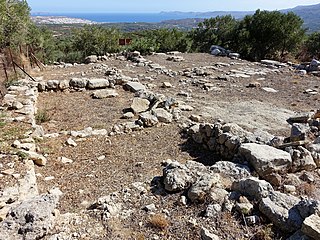
Pyrgos is an archaeological site of the Minoan civilization near Myrtos in the municipality of Ierapetra on the south coast of Crete.
Karfi is an archaeological site high up in the Dikti Mountains in eastern Crete, Greece. The ancient name of the site is unknown; "Karfi" is a local toponym for the prominent knob of limestone that marks the peak of the site, especially when viewed from the north. Located approximately 1100 meters above sea level, and overlooking the northern entrance to the Lasithi Plateau, the dramatic situation of Karfi is somewhat akin to that of the famous Inca site of Machu Picchu in Peru. While there is some evidence that the site was used during the Middle Minoan period as a peak sanctuary, Karfi is best known as a large and extensively excavated town of the Late Minoan IIIC period at the beginning of the Greek "Dark Ages."

Fournou Korifi is the archaeological site of a Minoan settlement on southern Crete.
Apodoulou is the archaeological site of an ancient Minoan mansion or ceremonial building.

Sklavokampos is the archaeological site of an ancient Minoan settlement in Crete, used during the Late Minoan period.

Vasiliki is the name of a village in the municipality of Ierapetra, in the prefecture of Lasithi, on Crete, and the name of the nearby Minoan archeological site. The site took its name from the village.

Achladia is the archaeological site of an ancient Minoan villa on eastern Crete.

Petras is the archaeological site of an ancient Minoan town on northeastern Crete.

Phourni is the archaeological site of an ancient Minoan cemetery in Crete. Phourni is Greek for "furnace, oven" and the name of the hill on which the cemetery is located.
Tripiti is the archaeological site of an ancient Minoan settlement in southern Crete, Greece, along the coast to the east of the village of Lendas.

Apesokari is the archaeological site of an ancient Minoan cemetery. It is also a modern village with a population of 103 (2011) and is built at 155 m above sea level. It is in the municipality of Gortyna in the south of Heraklion regional unit, Greece.
Odigitria is the archaeological site of an ancient Minoan religious complex including two tholos tombs located near the modern Odigitria Monastery in the Asterousia mountains of southern Crete.
Yerokambos is the archaeological site of an ancient Minoan cemetery in central Crete.

Armeni is the archaeological site of an ancient Minoan cemetery on Crete, roughly eight kilometers south of the modern town of Rethymnon.
Phylaki is a modern village and the archaeological site of an ancient Minoan cemetery on Crete.
Stylos is an archaeological site of an ancient Minoan settlement and cemetery near the modern village of Stylos on the Greek island of Crete. Stylos means "column" in Greek. Stylos is near the important archaeological site of Aptera in Chania regional unit. The site was first excavated by N. Platon and C. Davaras. A potter's kiln, a building with four rooms and a Late Minoan tholos tomb have been excavated.
Hagia Photia is an archaeological site of a fortified ancient Minoan building on eastern Crete. Sitia lies five kilometers to the west.
Vathypetro is an archaeological site, four kilometres south of the town of Archanes on Crete (Greece). It contains some of the oldest wine presses in the world. Excavations began in 1949 by the Greek archaeologist Spyridon Marinatos. The estate contains a manor house or villa which had a prominent role in the rural region around Archanes. The complex consists of several buildings, courtyards and workshop spaces. Next to the individual houses is the Minoan wine press, a plant for the production of olive, a Minoan kiln and ceramics, and the remains of an ancient pottery workshop.

Stylos or Stilos is a village and part of the Apokoronas municipal unit in the Chania regional unit of the Greek island of Crete. The Greek etymology of the name of the village is 'column' or 'pillar'. No existing topographical or surviving architectural feature could account for this naming.

Chamaizi is an ancient archaeological site in eastern Crete with a Middle Minoan IA oval-shaped building. Below this building is evidence of Early Minoan building foundations.













